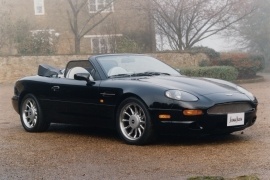
ASTON MARTIN DB7 Volante
Generations Timeline, Specs and Pictures

The Aston Martin DB7 was the rich brother of the Jaguar XK8 and, in 1999, it received a new version named Vantage or the coupe, and Vantage Volante for the convertible.
The Aston Martin brand was famed for staring in James Bond movies. But the DB7 was not chosen for any of the famous British spy agent. Strangely, in the 1999 movie “The world is not enough”, James Bond drove an Aston Martin DB5. Yet, the DB7 was already launched since 1997 when “Tomorrow never dies” appeared and 007 drove the same, classic, DB5.
The Vantage Volante was considered by many as a more powerful Jaguar XK8 instead of a true thoroughbred Aston Martin. There were many similarities between the two cars, starting with the base platform and with the styling. The curved long hood, shaped headlights, and low beltline. On top of that, a fabric roof was installed in the purest convertible fashion. The Vantage Volante had the power-activated soft-top and it consisted of multiple layers to ensure a better soundproofing and thermal comfort.
Inside the vehicle, there were four seats even though the rear ones were big enough to accommodate a tiny toddler. But the front seats were far more important, and those offered enough comfort for long cruises. The Aston Martin Vantage was a true Gran Tourer with a powerful engine. Its amenities were exclusive and the mix between wood and leather was typical for a British engineered car.
The standard vehicle came with a 6-speed manual transmission, but an option for a 5-speed automatic was available. The manual version was considerably faster but, for a more relaxed drive, the automatic was chosen more often.

Aston Martin unveiled an open-top version for the DB7 in 1996, two years after introducing the Gran Coupe.
The birth of the DB7 was long and painful. It was initially developed as a Jaguar XJS replacement, but further updates and innovations led to a turn toward the Aston Martin yard. The design team led by Ian Callum carried over other components from various brands owned by Ford to cut the development costs.
With an ageless design, the DB7 Volante featured a long hood shared with the coupe sibling and a raked windshield with thick A-pillars used as safety arches. There were no B-pillar. At the front, the car featured clear-lens covers for the headlights and the Aston Martin specific shell-shape grille with thin horizontal slats. Its wrapped-around plastic bumper sported Mazda MX5-originated turn signals and the parking lights. The carmaker installed vents behind the front wheel arches. Aston Martin carried over the chromed door handles from Mazda 323 station wagon. The same Japanese carmaker provided the taillights used for the 323 F.
Inside, the carmaker created a new dashboard with a rounded-shaped instrument cluster. Its panel sported two main dials and four additional gauges. A black sun visor surrounded the center stack covered in wood veneers. The leather-clad interior confirmed the luxurious status of the Aston Martin DB7 Volante. Unfortunately, its open-top was not completely retractable behind the seats, like other premium convertibles.
Under the hood, the carmaker installed a Jaguar 3.2-liter supercharged engine. Its inline-six provided 340 hp, which was considered adequate for those times.























































